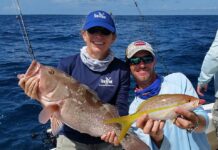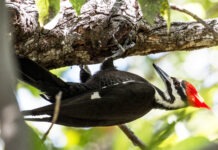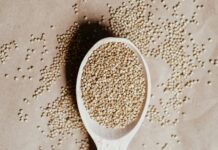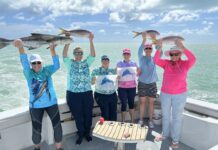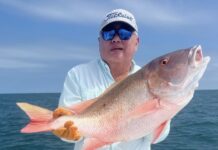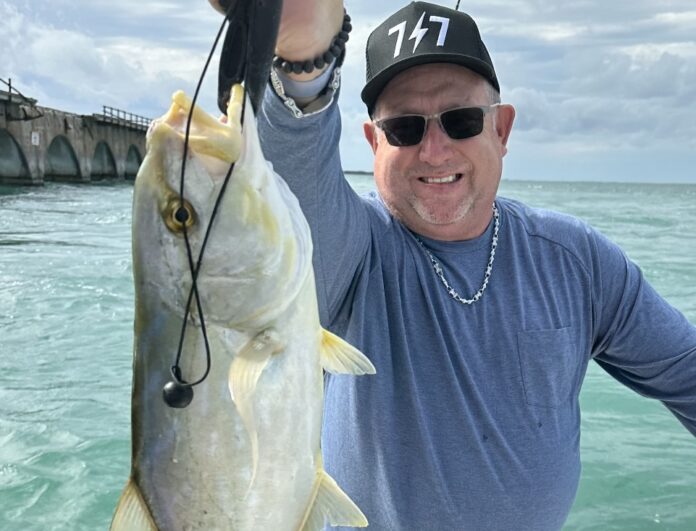
My grandpa John was a full-time charter captain in the Florida Keys and Flamingo from the mid-1940s to the mid-1980s. He never saw a yellow jack, much less caught one. Some of the old timers claim they’ve seen them in the past on occasion, but most of the ones I’ve talked to agree that yellow jacks showed up in the early ’80s. I’ve challenged several old timers to show me a picture of them or their clients holding up a yellow jack before 1980, and so far nobody has produced one. In fact, I’ve never seen a picture of one before 1990.
Today, yellow jacks are showing up all over the Gulf of Mexico and as far north as Massachusetts. Here in the Florida Keys we catch them in deeper water in the heat of the summer months and in shallower water in the cold of the winter months. In the spring and fall they are likely to show up anywhere, but they seem to school in bigger and tighter schools in the middle of summer and winter.
FWC and the marine biologists I’ve spoken with have little information about yellow jack migration patterns or spawning seasons. What’s known is they’re a hard-fighting game fish and they taste delicious. FWC fishing regulations call for a daily bag limit of 100 pounds per person.
A new world record yellow jack was caught on Sept. 1, 2021 by Peter Ernst, who caught a 19-pound, 7-ounce yellow jack in Key West. It took three months to get the final verification back and approved by the International Game Fish Association. The previous world record yellow jack was also caught in Key West and weighed in at 13 pounds, 4 ounces on July 12, 1980.
In the Keys we have several species of jacks. All are hard-fighting fish regulated by FWC. What they don’t have in common other than shape, color and size is taste. The most comparable jack to a yellow jack is the jack crevalle. Jack crevalle have the same or similar size, shape, color and fight as a yellow jack, but they taste bitter and are a bloody and bony fish, where yellow jack filets are beautiful white meat with two small and two large loins after removing the rib cage and blood line from its filet. They’re even suitable for sushi dishes served raw.
The greater amberjack is the largest in the jack family and taste just like a lesser amberjack or an almaco jack. In my opinion, they’re a great-tasting fish, but not quite as good as yellow jack.
Other jacks, including blue ridge jacks, bar jacks and blue runners, can be decent table fare but are smaller than the other jack species.
Yellow jack typically school when they’re feeding, and when you reel in a yellow jack, look for a half dozen others to follow in your hooked fish. We like to pick off the followers much like we do with mahi fishing, by leaving the hooked one in the water to attract the others.
Our favorite bait for yellow jacks is a yellow ¼-ounce jig tipped with a full live shrimp. We’ve also caught them with every bait fish around such as pilchards, pinfish, threadfin, grunts, goggle eyes, ballyhoo, finger mullet and more. We’ve also caught them on squid and pass crabs.
Yellow jacks get “leader shy,” so our favorite line to target them is 17.5-pound mono fluorocarbon. They are so smart it’s very hard to catch them on a clear day in clear water. They are best to target on an overcast day in murky water. It’s also best to target them on a quarter or half moon when the current is flowing slower. They are difficult to catch in a ripping current.
In the summer months we typically catch them in 100-plus feet of water around wrecks such as the Thunderbolt and rock piles such as the 7 Mile rubble pile. In the winter months we find them mostly on the Gulf side in defined channels such as Money Key channel. In the spring and fall we find them on the Gulf and Atlantic sides around shipwrecks and sunken barges.
We wish all y’all a safe and productive upcoming fishing and tourist season.
To book a charter with Ana Banana, call or text Capt. Joel at 813-267-4401 or Capt. Jojo at 305-879-0564, or visit anabananafishing.com.









